Sabudana Vada (Maharashtrian Style)
Just like any new bride, the first few months saw me frantic in the kitchen, cooking up a storm. Though I knew basic cooking (thanks to a judicious and proactive mom), I was not one of those who loved cooking or even interested in knowing more about it. My passions were all over and everywhere but here. But given that I had to do it, I thought I might as well do a good job out of it and enjoy I sure did. It helps a great deal when the person you are cooking for takes extreme interest in eating up all that you made and in providing valuable feedback aimed at betterment.
Snacks were a highlight every day (with the weather at that place being cloudy at least 350 days a year) and among the myriad ones I tried, these made their appearance on and off. About 90% of the Maharashtrian recipes I know is courtesy my mom who meticulously jotted them down in her recipe diary during our stay in the North. Like I said before (see my Batata Poha and Kanda Poha post), I started loving few dishes without knowing where they are from. These vadas follow the same norm. Extremely popular during the Navartri (Dussera) festival time among the Maharashtrians, these can also be enjoyed during the rest of the year.
Basic Info:
Ingredients
- 1 cup (abt 170 grams/6 oz) Sabudana (Sago pearls), see Tips
- 2 cups (abt 2 large) Potatoes, boiled and mashed
- 1/2 cup Peanuts
- 1 tsp Cumin
- 2-3 Green chillies, or per taste, thinly sliced
- Pinch of Sugar
- 1 tsp Lemon juice, or as per taste
- Salt to taste, see Tips
- Few sprigs of Cilantro to garnish
- 2-3 tsp Rice flour, for dusting (optional) - See Tips
Tips
- Sabudana : Depending upon the size and quality, the prep also changes. The smaller varieties need only around 15-20 minutes of soaking, while the larger kind needs soaking for 5-6 hours (or preferably overnight). Strictly, the quality also has a huge role in the soaking. The best quality requires just a sprinkling of water to make it soft and spongy. With trial, you would have to find out under what category your Sago pearls fall under. I have used large pearls for this recipe.
- Salt: If preparing this recipe for Fasting (Vrat), use Rock Salt (Sendha Namak) instead of regular salt.
- Rice flour: Its totally optional which I use for dusting and also to provide crispiness to the Vadas. But if you are preparing this for the Dussera Fasting, then I would suggest using Rajgira Atta ( Amaranth flour) or Singhara ka Atta (Water Chestnut Flour) or a combination of both to help not only in the binding but also to provide extra flavor. You won't need much for the binding and this recipe works without any flour too.
Method
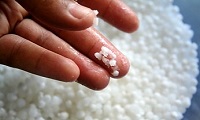
- Wash the sabudana well and then soak it overnight with just enough water to cover it. You will find that the water has been absorbed by the sago and it will look plumped up. Refer Tip1 for details on the type of Sago to use.
- When you press the pearls with your fingertips it should get mushed up.
- Now drain the sago well - at least 15-20 minutes. Make sure there is no water in them before using in the recipe.
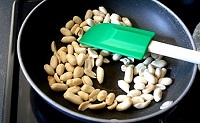
- While that's draining, dry roast the peanuts until browned
- and coarsely chop them. You can grind it into a powder but the coarseness provides a wonderful texture along with a delightful crunch to the vadas.
- Now mix all the ingredients in a large bowl (except the flour)
- and mix until combined. You will see (if you took care to drain out water from both sago and boiled potatoes) that it really doesnt need binding to shape into vadas. But you can add few tsp of suggested flours (see Tip 3) for extra flavor (and binding if you think you need it).
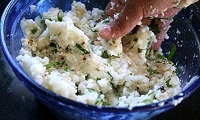
- I dusted by hands with little rice flour and shaped them into medium sized patties.
- Repeat for all of them. You can refrigerate this mixture at this point which I personally think helps in avoiding retention of oil (which sabudana wadas are notoriously famous for!)
- Heat oil for deep frying. Make sure to keep the temperature at 350F to 375F for making the crispy wadas without oil retention.
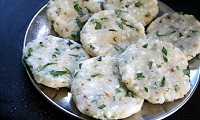
- Drop the Wadas to the oil, 2-3 per session, or as little (or as many) your vessel can hold. But make sure to adjust the heat accordingly.
- Turn on the other side for uniform browning.
- Remove and place it on paper towels.
Serve hot with any accompaniment of your choice. The best wadas are those that taste crispy on the outside and soft and chewy on the inside. This is perfect for monsoons, evening snacks or any time throughout the year and not just during fasting days :)
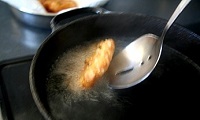
Enjoy!